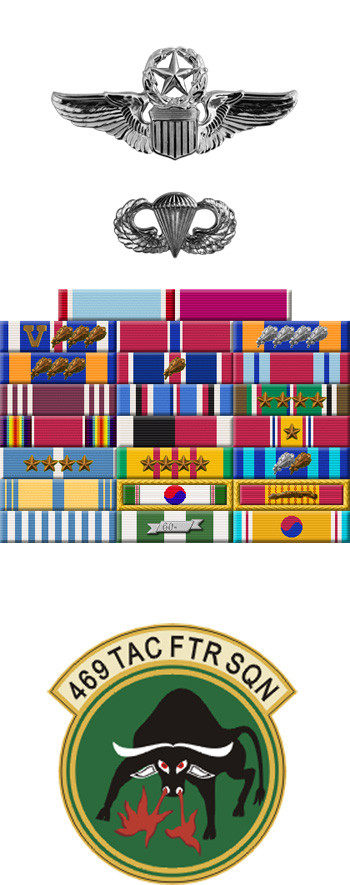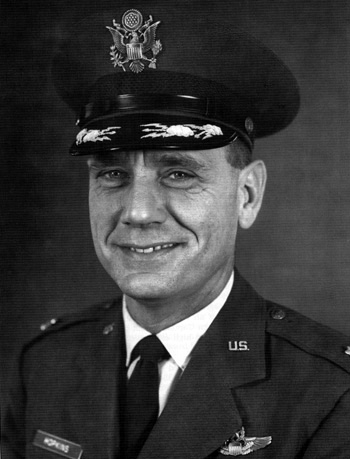
|
James R. Hopkins |
 |
|||
| Rank, Service | ||||
Colonel O-6, U.S. Air Force |
||||
| Veteran of: | ||||
|
||||
| Tribute: | ||||
Jim Hopkins was born on December 21, 1923, in Clinton, Iowa. He enlisted in the U.S. Army Air Forces on December 30, 1941, and was trained as an aircraft mechanic. Hopkins served at Patterson Field, Ohio, until August 1942, when he entered the Aviation Cadet Program. He was commissioned a Flight Officer and awarded his pilot wings on April 29, 1943, and then served as an instructor pilot at Walnut Ridge Army Air Field, Arkansas, until April 1944, when he transitioned to the P-40 Warhawk and then the P-47 Thunderbolt. Hopkins served in Europe from October 1944 until the end of the war, and then left active duty and joined the Air Force Reserve on December 21, 1945. He was recalled to active duty on December 13, 1947, and then attended Armament School before serving with the 60th Fighter Squadron of the 33rd Fighter Group at Walker AFB, New Mexico, and then at Otis AFB, Massachusetts, from June 1948 to July 1949. Hopkins next served as an instructor pilot with the 3555th Pilot Training Wing at Perrin AFB, Texas, from August 1949 to July 1950, followed by service with the 16th Fighter Interceptor Squadron of the 51st Fighter Interceptor Group in South Korea, where he served from September 1950 to May 1951. He then served with the 44th Fighter Bomber Squadron of the 18th Fighter Bomber Group at Clark AB in the Philippines from May to July 1951, followed by service with the 83rd Fighter Interceptor Squadron at Hamilton AFB, California, and then at Paine AFB, Washington, from September 1951 to August 1956. Hopkins served with the 321st Fighter Squadron, also at Paine AFB, from August 1955 to February 1956, followed by service as an Advisor to the Michigan Air National Guard from February 1956 to April 1960. He transferred to the 81st Tactical Fighter Wing at RAF Bentwaters, England, in April 1960, and served as a staff officer and later as Commander of the 91st Tactical Fighter Squadron (TFS), until July 1963, when he joined the 333rd TFS of the 4th Tactical Fighter Wing (TFW) at Seymour Johnson AFB, North Carolina. Col Hopkins became Commander of the 336th TFS at Seymour Johnson in May 1964, and then became Assistant Deputy for Operations of the 4th TFW in October 1965. He deployed to Southeast Asia in January 1966, and served with the 469th TFS of the 388th TFW at Korat Royal Thai AFB, Thailand, until November 1966. Col Hopkins was Commander of the 469th from May to November 1966. His next assignment was as an Advisor to the Illinois Air National Guard, where he served from November 1966 to August 1967, followed by service as Assistant Deputy Commander for Operations of the 4520th Combat Crew Training Wing at Nellis AFB, Nevada, from August 1967 to January 1968, and then as Assistant Director of Operations for the 474th TFW, also at Nellis, until August 1968. He attended Air War College at Maxwell AFB, Alabama, from August 1968 to May 1969, and then served as Chief of the Offensive Operations Division of the 6003rd Support Squadron at Hickam AFB, Hawaii, until June 1970, when he became Vice Commander of the 326th Air Division, also at Hickam. Col Hopkins became Commander of the 326th in July 1972, and then served as Base Commander of Luke AFB, Arizona, from July 1973 until his retirement from the Air Force on May 31, 1974. Jim Hopkins died on May 10, 2010. |
||||
|
||||

